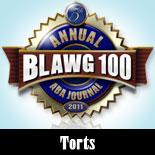Today, Abnormal Use continues its series, “Abnormal Interviews,” in which this site will conduct interviews with law professors, practitioners and makers of legal themed popular culture. For the latest installment, we turn to Brook Bristow, a brewery lawyer based in Greenville, South Carolina. You may remember that we’ve done a few beer related interviews in the past, the first with Adam Avery of the Avery Brewing Company about its Collaboration Not Litigation Ale, the second with Daniel Hartis, the author of the book Charlotte Beer: A History of Brewing In The Queen City. There have been some recent changes in South Carolina’s brewery laws, and because we like to talk about beer, we asked Brook to answer a few questions for us. He was kind enough to agree. The interview is as follows:
1. How is South Carolina responding to the craft beer movement?
When it comes to change in South Carolina, I always like to say that we have two speeds: slow and stop. However, craft beer has been an exception to that rule. In fact, the craft beer movement has only really hit South Carolina in the last ten years. Since 2007, the law has been changed three times when it comes to local breweries. That’s incredible. Prior to 2007, brewers here couldn’t make anything over 5 percent ABW. Now, with the changes in law, our breweries are producing world class beers and are gaining notoriety nationwide. We’re producing many jobs both in the craft beer industry and related ones. Additionally, since the law was changed in 2010 to allow beer tastings at breweries, we’ve seen a proliferation in the number of breweries opening, with more on the way. We have many bottle shops throughout the state that offer growlers, bottles, and kegs. Our fan following has grown exponentially the last few years, as more and more people are exposed to craft beer. We’re also seeing a significant increase in beer tourism. On a weekly basis, there are hundreds of craft beer enthusiasts that attend tours and tastings at the breweries. Many of these patrons are coming from surrounding states, as well as many reported foreign visitors. This is true of all of the breweries in South Carolina. We’re also having quite a bit of reach. For example, while I was in Colorado recently at Rocky Mountain National Park, my girlfriend and I actually pulled off the road to view some elk. A guy who worked at the national park actually walked up to me because he saw my Holy City Brewing shirt and started telling me about how much he loved their brown ale called Pecan Dream. It was unbelievable to see the reach that our brewers are starting to have.
2. What do you think is the biggest legal obstacle to small brewers in South Carolina?
Prior to the passage of the new Pint Law, it would have been the inability to sell more than four 4 ounce tasters glasses to a consumer per day. That was a big source of revenue that was being missed out on, not to mention the beer tourism implications. The biggest issue now is probably excise taxes. While there is some proposed legislation in Washington to reduce the federal excise rate on brewers who make less than 60,000 barrels of beer per year, the bigger problem is the South Carolina excise tax. For every gallon of beer, there is a $0.77 excise tax. That’s good enough for being in the top ten of states that charge the most on beer. Compare that with states at the bottom, like Wyoming that only charges $0.02, Colorado and Oregon at $0.08, and Montana at $0.14. That would be a big savings.
3. What do you think is the biggest obstacle to consumers of craft beer in South Carolina?
Compared to where we were a year ago, craft consumers have it pretty good in South Carolina. Sure, you’ll occasionally hear complaints that there is a consumption limit of 48 ounces in brewery taprooms per day, but people understand how far we have come. Perhaps one obstacle for some craft beer consumers in the state is the availability of local beer in some areas, but this has changed in recent years. While some areas of the state do not have their own local brewery yet, we’ve seen very large growth over the last few years and certainly after the recent change in law on tastings. I’d expect that trend to continue and for breweries to keep popping up all over South Carolina.
4. What do you think has been the biggest legal victory for the craft beer movement in South Carolina?
There have certainly been a few going back to 2007. The Pint Law was huge and the tasting law before that was very big. But, you have to start somewhere and the Pop the Cap movement was the catalyst for everything. Pop the Cap was the effort to raise South Carolina’s ABW cap on beer. When the movement started in 2005, the cap was a mere 5 percent ABW. After a long and grueling effort to educate the public and legislators, the law was changed in 2007, which raised the cap to 14 percent ABW. What that did was it allowed South Carolina brewers to make new beers, to be more creative, and to educate the public about what craft beer could be. Without Pop the Cap, South Carolina wouldn’t be where it is today.
5. What was the Pint Bill, and how did it come about? What’s next in light of that victory?
Since 2010, our breweries have been allowed to have limited tastings. Prior to passage of the Pint Bill, breweries were only allowed to serve 4 tasters to customers (at most). Usually, those were 4 ounce tasters; however, if the ABW was high enough, then the specific beer could only be a 2 ounce pour. So, at best, as a customer you could come to a brewery and only have 16 ounces in tasters. As for growlers to take off-premises, the law was the same as it is now – 288 ounces. It’s important to note that our breweries just won the right to have tastings at all in 2010. Prior to that, breweries could do nothing but produce beer. The Pint Bill was an effort to boost the revenues of the breweries and also allow them to start competing more meaningfully with the states around us, including North Carolina, which has much more expansive laws. Like everyone, we saw that those laws not only led to a boom for new local breweries, but also landed the state two $100 million plus investments by West Coast breweries that are moving East – New Belgium and Sierra Nevada. That in addition to the millions of dollars being contributed by a third large West Coast brewery – Oskar Blues. Prior to passage of the bill, those breweries wouldn’t have even considered South Carolina. However, now, we can at least provide some incentive for popular western breweries that would like to expand their operations to the east coast. The Pint Bill (now Law) provides that our breweries can sell 48 ounces a day to a consumer for on-site consumption. There are many restrictions that go along with that, but the concessions made for passage were more than worth it.
What’s next? More breweries on the way, for sure. Quite a few in fact. By my last count, we’ve got at least nine in planning with probably about four opening up in the next few months. It’ll be interesting to see how we deal with this golden age of craft beer in South Carolina. We’re well on our way to having about 20 breweries open by the beginning of next year. That’s a new experience for us. I’m hopeful that we can not only maintain those numbers, but continue to grow them and produce great quality beer.
6. How has the expansion of social media assisted in the growth of the craft beer movement?
It’s been huge. It certainly was instrumental in getting the word out for advocacy on the Pint Law here in South Carolina. It’s also being used with great success nationally, whether that is in Tennessee with efforts to reduce the nation’s worst beer excise tax or recently in Alabama and Mississippi to finally legalize homebrewing. As to craft beer generally, it’s a great way to communicate with other beer fans nationally and internationally, as well as to find out what is new from the growing number of breweries across the country. While some might complain that it has added to the sometimes unwarranted hyping of certain beers and breweries, to me, it’s like any other information source – that being you should take what you see and hear with a grain of salt, and evaluate it for yourself. If nothing else, it’s a way to keep yourself informed of what’s going on in a more up-to-the-minute sense.
BONUS QUESTIONS:
Favorite South Carolina beer?
It really is hard to go wrong with craft beer in South Carolina. Some of my favorites are Holy City Brewing’s Pluff Mud Porter, Coast Brewing’s Barrel Aged Blackbeerd Imperial Stout, Brewery 85’s Quittin’ Time, and Quest Brewing’s Kaldi Imperial Coffee Stout.
Favorite North Carolina beer?
There is certainly is a wide selection! I’ve always enjoyed what I have had from Foothills in Winston Salem and Fullsteam in Raleigh. At the moment though, I’m fascinated with Burial Brewing in Asheville. It’s an up-and-coming nanobrewery co-owned by a former brewery lawyer from Seattle. Their Voorhamer Imperial Stout is one of best I have had.
Favorite non-Carolina beer?
Depends on my mood, but I’m a big fan of Founders Breakfast Stout, Heady Topper, Black Tuesday, and Parabola.
Favorite style of beer?
Easily, imperial stout. But I also like porters and bigger IPAs.
Favorite beer related website?
Believe it or not, I don’t go on too many beer blogs. Since part of my law practice entails representing breweries, the Brewers Association website is a great resource on some of the issues involved, so I check that out on a regular basis.
Favorite song about beer?
I’ll go the dive bar route and go with George Thorogood’s “One Bourbon, One Scotch, One Beer.”
BIOGRAPHY: Brook Bristow is an associate in the office of Bradford Neal Martin, PA in Greenville, South Carolina. His practice is primarily in business and employment law, where he represents local businesses, including several South Carolina breweries. He runs the Beer of SC beer blog, where he focuses on legal issues affecting small brewers, especially in South Carolina. He also works with the South Carolina Brewers Association on legislative and legal issues. You can follow him on Twitter at either @beerofsc or @brookbristow.





















